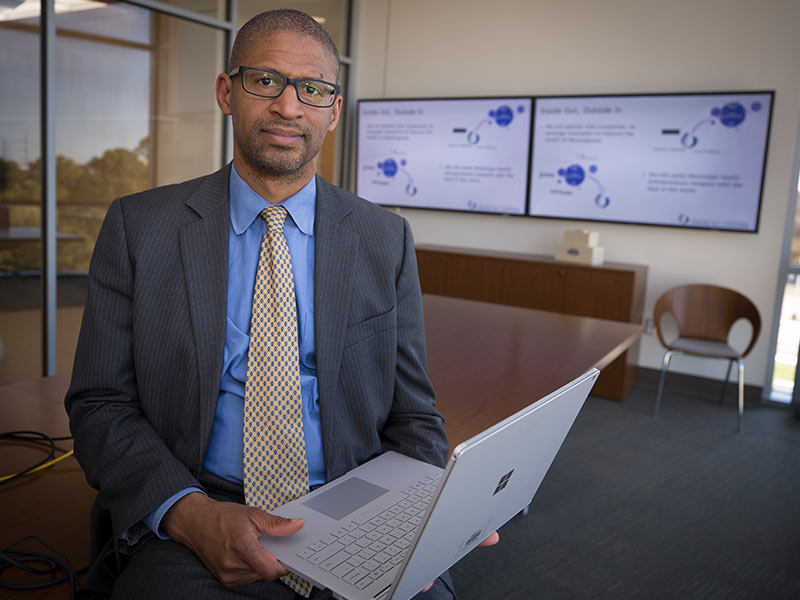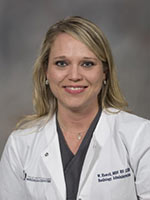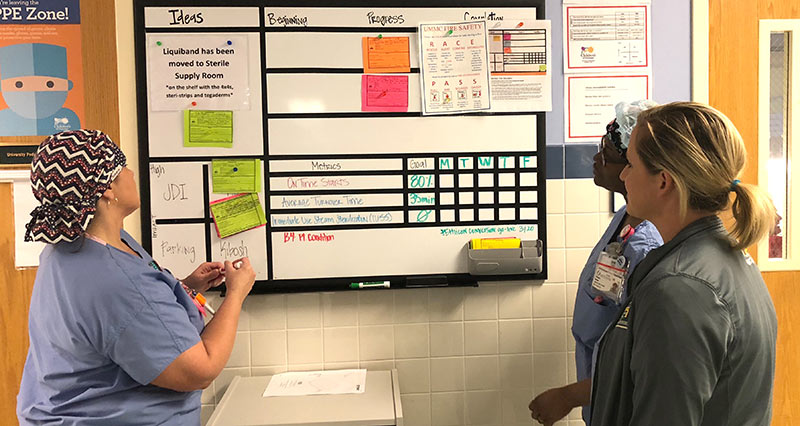New innovation center HITs ground running

Solving the greatest health challenges requires a change in thinking. The Health Innovation and Transformation Center is here to help foster those new ideas.
Since receiving official center status in late February, the HIT Center’s goal is to advance the University of Mississippi Medical Center’s missions by supporting health care-related innovations on campus and across the state. The center will also connect UMMC with new technologies and approaches across the country.
What’s the purpose? If the goal is to improve the health of Mississippians, “what got us here won’t get us there,” said Terrence Hibbert, director of innovation.
“Our objective is to implement innovations that will improve health care for Mississippians,” Hibbert said. “The HIT Center will take an active role in helping innovators secure resources that will make their ideas a reality.”
That includes working with UMMC’s Tech Transfer Office to evaluate innovations and help their creators apply for patents, develop prototypes or connect with computer programmers. The HIT Center will also help determine which outside innovations are worth adopting in clinics, labs and classrooms.
“New technologies are coming out quickly and the Medical Center has no way to absorb, evaluate or figure out if this technology is helpful or simply tech for tech’s sake,” Hibbert said. “The HIT Center will evaluate outside innovations before deciding to implement them at UMMC.”
The idea for the HIT Center came from the convergence of three approaches to improving UMMC: the Center for Informatics and Analytics devising health care solutions, the Division of Information Systems seeking to evaluate new technologies, and University Research focusing on advancing the institution’s discovery enterprise.
“It’s important for us to be on the cutting edge of innovation,” said Dr. Richard Summers, associate vice chancellor for research. “We already have the tools to do this, but we need to shepherd these new ideas.”
A few of these assets, or “drivers of innovation” as Hibbert calls them, include the Bower School of Population Health, the Center for Telehealth, the Enterprise Data Warehouse, the Biobank and the Clinical Trials Unit.
So what is an innovation, anyway? It could be a new tool and technique, Hibbert said, but also a new way of using an existing resource.
One project the HIT Center is following is a collaboration to develop a better way to identify patients needing follow-up for pulmonary nodules detected during various imaging procedures.
Wendy Howell, clinical outcomes coordinator in the Department of Radiology, worked on the project as part of her Master’s thesis in the School of Nursing. Along with the Center for Informatics and Analytics, she used the medical dictation software M*modal and natural language understanding to create and validate an automated “search engine” of a radiologist’s notes for nodule-associated words and numbers.

“The previous workflow was time-consuming and tedious,” Howell said. “Before, we were using nine different tools to search this data because we didn’t have one tool that could do it all.”
The older system identified 125 nodules in one month. With the new M*modal system, they found 380 during the same time period, including five not flagged by the older system.
“We were able to find a large percentage of pulmonary nodules, even some that we otherwise would have overlooked,” Howell said.
And because the software didn’t have a built-in protocol for nodules, UMMC is using it in an innovative way, said CIA intelligence program manager Keith Hodges.
“We took the current product and used it in an unintended, different way,” Hodges said.
However, innovation doesn’t need to be high-tech to change health care.
“People look to technology as an avenue for innovation, but a big part of innovation is also looking at other industries to learn how they manage challenges,” Hibbert said.
It can literally be as simple as a dry-erase board, markers and teamwork.
Batson Children’s Hospital perioperative services and UMMC Grenada use visual management boards to identify challenges, devise actionable solutions and track their progress.

“We work in a field where change is oftentimes met with resistance,” said Hailey Moore, a nurse educator in the Children’s OR. “After a few weeks of trial and error, our team began to embrace this approach as a catalyst to change. As a result, problems that had been plaguing us for years were being fixed, our team members were happier and our patients were safer.”
Moore and other team members recently won a clinical innovation and quality improvement award from the Association of Perioperative Registered Nurses for their visual management board approach. They will present this work at the organization’s conference the week of March 24.
Originally, visual management boards come from lean manufacturing principles, pioneered by automobile producers and used primarily in business settings.
“The innovation lies in taking this lean manufacturing tool and translating it into a health care setting,” said Jeff Dunaway, performance improvement director.

Other universities have innovation hubs similar to the HIT Center. However, Hibbert said UMMC has a different approach.
“Some universities have a high focus on supporting their in-house innovators, while others are proactive consumers of innovation and buying technologies,” he said. “We’re trying to move the needle on health in Mississippi and drive value for UMMC.”
As part of that goal, the HIT Center will hold its first event May 15, a forum to bring together Mississippi and global health innovators, researchers, clinicians and advisors from Plug and Play Tech Center, a California-based startup investor and incubator.
The interactive event is an opportunity to share health-related ideas through poster presentations, business plan competition, networking and a “Shark Tank”-like business pitch session. The winning ideas from that competition will receive funding from Plug and Play investors.
The Bower Foundation, a supporter of health care solutions across Mississippi, provided a grant to fund the HIT Center’s relationship with Plug and Play. The affiliation is a “two-way vehicle” that allows Medical Center innovators to get advice and investments from a global network and gain access to outside innovations.
This connection to possible sources of outside investment and joint ventures is critical to furthering Mississippi’s economic development innovation. Without it, UMMC and other institutions face a risk of losing some of their greatest innovators and ideas.
“We want to mitigate that risk at the beginning,” Hibbert said. “This is a link to Silicon Valley without having to leave Mississippi.”


